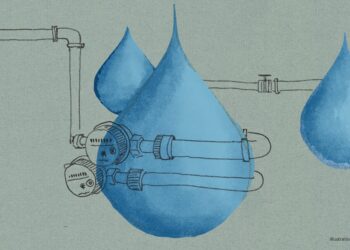
Listen to the article.
Armenia ratified the Paris Agreement on climate change in 2017. Seven years later, this overview examines the regulatory measures Armenia has taken to implement key provisions of the treaty—focusing on mitigation, adaptation, transparency, and compliance. The aim is to highlight achievements and identify areas needing further work. It’s important to note that this is not a comprehensive compliance assessment, but rather a stocktake of regulatory actions—a necessary step toward ensuring full compliance.
Context
On December 12, 2015, at the UN Climate Change Conference (COP21) in Paris, 196 states adopted the Paris Agreement––a legally binding international treaty on climate change. This agreement renewed the climate commitments initially set out in the 1997 Kyoto Protocol and continued the process of the 1992 UN Framework Convention on Climate Change. The Paris Agreement sets both temperature and emissions goals, aiming to address climate change by: 1) Holding the increase in global average temperature to well below 2°C above pre-industrial levels; and 2) Pursuing efforts to limit the temperature increase to 1.5°C above pre-industrial levels.
To meet these temperature goals, Article 4 of the agreement requires parties to: 1) Reach global peaking of greenhouse gas (GHG) emissions as soon as possible and undertake rapid reductions thereafter; and 2) Achieve a balance between anthropogenic emissions by sources and removals by sinks of greenhouse gasses (net-zero emissions) in the second half of this century.
In November 2024, nearly a decade after the adoption of the Paris Agreement, 195 state parties are in Baku for COP29 to review collective progress toward the agreement’s certain provisions, purpose and long-term goals. Armenia ratified the Paris Agreement in March 2017 and has regularly participated in all COPs,[1] with delegations of 30-40 members.[2] However, while COP29 has already kicked off, Yerevan has not yet confirmed its participation, largely because Baku is illegally keeping Armenian prisoners of war and civilian detainees.
COPs are important, typically week-long events. For developing countries, implementing the agreement’s obligations is a daily, resourceful, and arduous process, often demanding significant shifts in thinking, doing, and structures. Armenia has been implementing its Paris Agreement obligations domestically for the past seven years. Despite its decision to skip COP29, this seven-year mark provides a significant opportunity to assess where Yerevan stands between Paris (COP21) and Baku (COP29), particularly regarding the legal measures needed to meet the Paris Agreement’s requirements.
The Nature of Legal Obligations Under the Paris Agreement
To assess Armenia’s progress in fulfilling its obligations under the Paris Agreement, it is essential to understand the legal nature of its commitments. The question of the legal form of the future document was central [3] even during the drafting of the 2011 Durban Platform, which provided the mandate for the Paris negotiations. The adopted agreement is a legally binding treaty as defined in Article 2 of the Vienna Convention on the Law of the Treaties. However, a treaty’s legally binding nature does not automatically make all its provisions binding. Since the adoption of the Paris Agreement, scholars have extensively debated the binding nature of its specific provisions.[4]
Particularly the formulations in Article 4.2 on nationally determined contributions, considered “the center of gravity” of the Paris Agreement.[5] The careful use of legal terms (“shall”, “should”, “party”, “parties”) and phrases (“enhance understanding”, “encouraged to”) resulted in mainly procedural obligations alongside provisions of goals, values, and expectations.[6] As Daniel Bodansky aptly describes it is: “…a Goldilocks solution that is neither too strong (and hence unacceptable to key states) nor too weak (and hence ineffective).”[7]
While a detailed analysis of the legal nature of the agreement’s specific provisions is beyond our scope, it is important to highlight a few key points. Many obligations in the Paris Agreement are “obligations of conduct” (similar to due diligence in common law) rather than “obligations of result”. This means they set expectations for states to work towards goals instead of demanding specific outcomes. In other words, they encourage progress without guaranteeing results.[8] Additionally, the agreement contains a mix of binding and non-binding obligations.
Recognizing these legal nuances, this reflection assumes that in the international legal system—with its limited authority of enforcement[9]—the debate on treaty provisions’ bindingness is relative to the domestic context. Additionally, a treaty in force is binding upon its parties in its entirety and must be performed in good faith. This discussion acknowledges Benoit Mayer’s argument that obligations of conduct are not inherently weaker than obligations of result,[10] especially given the existence of a benchmark (Nationally Determined Contributions—NDCs) in the agreement against which the mitigation efforts of states can be assessed. In other words, for a developing country like Armenia with an incremental 0.02% contribution to the total global greenhouse gas (GHG) emissions and the lower range per capita CO2 emissions with 2.20 tons per person (mitigation context), but with significant vulnerability to the changing climate, recognition that Article 7’s provisions on adaptation “are more general and, for the most part, are hortatory and expository rather than obligatory” should not undermine mitigation efforts. This is crucial if the Paris Agreement is to have an effect on regulating domestic efforts to combat climate change.
The Paris Agreement in Armenia
With these considerations in mind, let’s examine the legal measures Armenia has taken so far to comply with key provisions of the Paris Agreement concerning:
- Mitigation (NDCs),
- Adaptation,
- Transparency, implementation and compliance.
Mitigation
According to Armenia’s Third Biennial Updated Report (Third BUR), energy and agriculture are Armenia’s largest sources of GHG emissions. Energy contributes 66.7%, while agriculture accounts for 18.5%. The remaining 14.7% comes from industrial processes (8.9%) and waste (5.8%).
Armenia’s mitigation potential lies primarily in the energy and agriculture sectors. To harness this potential, Article 4, paragraph 2 of the Paris Agreement obliges Armenia to prepare, communicate, and maintain successive nationally determined contributions (NDCs) every five years. It must also pursue domestic mitigation measures to achieve the objectives of its contributions (Article 4.2).
While developed countries are expected to lead by undertaking economy-wide absolute emission reduction targets, Armenia, as a developing state, should continue enhancing its mitigation efforts. It is encouraged to move over time toward economy-wide emission reduction or limitation targets based on its national circumstances (Article 4.4).
Furthermore, under Article 4.13 Armenia shall account for anthropogenic emissions and removals corresponding to its nationally determined contributions (NDCs). This accounting should follow procedures, rules, and principles that allow others to understand its NDC targets and include the obtained data in the assessment of collective progress towards the long-term mitigation goal.[11]
The Government Decision “On the approval of the domestic actions of the Republic of Armenia under the Paris Agreement for the period of 2021-2030” outlines Armenia’s NDC. This document details the scope of related programs and actions, priority adaptation areas, and the methodologies and assumptions used to ensure transparency and fairness of the NDC.
Armenia submitted its Intended Nationally Determined Contribution (INDC) to the UNFCCC in 2015, which became its official NDC after ratifying the Paris Agreement. The mitigation goal of these NDCs is to reduce GHG emissions to a maximum of 2.07 tCO2eq/capita between 2015 and 2050. To reach this goal, Armenia has set a specific, ten-year NDC implementation period (2021-2030) to focus on reducing emissions by 40% compared to 1990 levels, when emissions were 20.6 million tons. This means Armenia aims to reduce emissions by an additional 1.92 million tons from its 2022 levels of 6.33 million tons.
Regarding domestic mitigation measures, Chapter 3 of Armenia’s Third BUR outlines mitigation actions by sector. In the energy sector, efforts focus on reducing CO2 and CH4 emissions through an increased share of renewable energy in the power generation mix and energy efficiency measures for power suppliers. The bulk of emission reductions in this sector is expected to come from medium and large utility-scale solar power farms (e.g., Masrik1- 55 MW and other PVs with 120MW capacity by 2024 and two Solar PVs with 200 MW capacity in 2023 and 2024), upgrading and commissioning large and small hydropower plants, and reducing losses in electric networks.
The energy sector strategy and timeline, adopted by Government Decision N 48-L in January 2021, commits Armenia to increase solar energy’s share in overall energy production to at least 15% (1.8 billion kWh) by 2030. This will be achieved by building solar power plants with a capacity of about 1,000 MW. The Government also plans to build small and system-scale wind farms with a total capacity of up to 500 MW between 2025 and 2040, contingent on the competitiveness of the sector. Armenia aims to increase the share of electricity generated from renewable energy resources—including large hydroelectric power plants—to about 50% by 2030, and about 60% by 2040. However, modeling of baseline scenarios revealed that the planned measures would achieve the lowest level of greenhouse gas emissions if nuclear power is included. The government considers this consistent with its long-term goals of low-emission development and national energy security.
The Third BUR highlights the potential for reducing GHG emissions through autonomous renewable power generators and improved building energy performance. This is particularly relevant given Armenia’s inherited stock of multi-apartment housing from the USSR era, which has minimal or no energy efficiency standards. Recent regulations on building energy efficiency, however, primarily target new constructions or buildings under state-funded reconstruction (such as schools or governmental buildings). For the most energy-inefficient existing buildings, these rules only apply if owners choose to renovate common areas to increase energy efficiency.
In recent years, the country has begun constructing two PV power plants: the medium-scale Masrik1 (62MW) and the large-scale Ayg1 (200MW). While Masrik1 is set to be commissioned by the end of this year, Ayg1’s future is in jeopardy. The cabinet’s decision to dissolve the Armenian National Interest Fund, which was responsible for implementing a $174 million deal with the UAE’s Masdar company, has cast doubt on the project. Regarding nuclear power, Armenia is in talks with the United States about building a new nuclear power plant, possibly including small modular reactors. This comes as the current plant, built in the 1970s, is scheduled for decommissioning in 2036.
Regarding the agricultural sector, the third BUR envisages improving cattle gene pools (by 2025) and implementing rotational grazing technologies (ongoing). Moreover, adapting the agricultural sector to climate change—including enhancing its resilience and agroecological systems—is central to Armenia’s economic strategy in the agricultural sector for 2020-2030. This strategy promotes climate-conscious investments, green technologies, and programs to address climate risks. However, the sector’s development plan in Annex II of the decision omits mitigation measures. While a comprehensive evaluation of the third BUR and sectoral strategies exceeds this article’s scope, this overview highlights Armenia’s efforts to prepare, communicate, and implement its NDCs and related mitigation actions.
To conclude, Armenia has prepared and submitted its successive NDC and is pursuing mitigation efforts. Under Article 4.4 of the Paris Agreement, Armenia is encouraged to adopt economy-wide emission reductions over time, yet it chose this approach from the start. However, its energy policy goals—such as achieving 15% solar energy and 50% renewable electricity by 2030—aren’t directly linked to GHG reduction targets. With the success of one measure and the failure of another, it is uncertain whether the country can meet its NDC target. In agriculture, the focus remains on adaptation without specific mitigation targets or detailed measures, although the third BUR lists two actions. Furthermore, the lack of monitoring for domestic policy measures, make it difficult to track sectoral mitigation measures and their contributions to the NDC.
Adaptation (Article 7)
Armenia is highly vulnerable to climate change, with trends mirroring global patterns. According to the National Climate Change Adaptation Action Plan and Its Measures for 2021-2025, average annual temperatures rose by 1.23°C between 1929 and 2016, while annual precipitation fell by about 9% between 1935 and 2016 compared to 1960-1991 levels. Hot days and nights have become more frequent, while cold days and nights have significantly decreased. Climate change has led to a marked increase in the frequency and intensity of natural disasters, disproportionately affecting vulnerable groups—those economically disadvantaged or marginalized by gender and other factors. Between 1975 and 2016, there was an increase in cumulative incidents of hydrometeorological hazardous phenomena (HHP)—frostbite, hail, strong winds and heavy precipitation (Figure 2). Forecasts suggest that by 2100, temperatures across the country could rise by up to 4.7°C, accompanied by an 8.3% decrease in average annual precipitation.
Article 7, paragraphs 1-8 of the Paris Agreement establish the global goal on adaptation. This includes enhancing adaptive capacities, strengthening resilience and reducing vulnerability. These paragraphs recognize adaptation as a global challenge, especially for developing countries, and acknowledge the significant need for adaptation. They also stipulate that adaptation action should follow a country-driven, gender-responsive, participatory, and fully transparent approach, based on cooperation. However, it is Article 7.9 that creates a direct obligation for states to engage in adaptation planning processes and implement actions. This includes developing or enhancing relevant plans, policies and contributions.
To meet its obligations, Armenia adopted its National Action Plan (NAP), which outlines two key aspects. First, it details cross-sectoral measures to enhance institutional capacity for identifying, prioritizing, and funding adaptation actions. Second, it includes targeted adaptation measures in six priority areas—water, agriculture, energy, settlements, health, and tourism—as well as two pilot regions. Notably, the NAP provides a framework for integrating adaptation planning into local governance, sectoral policies, and financial planning, thus coordinating adaptation efforts across sectors. In essence, the NAP articulates Armenia’s commitment to adaptation and highlights areas of focus.
Regarding the implementation of the adaptation actions, the NAP outlines 26 actions to be carried out from 2021 to 2025. Six of these actions involve adopting adaptation plans for the previously mentioned priority areas. As of November 2024, Armenia has adopted only the “Climate Change Adaptation Program for the Period of 2022-2026 in the Water Resources Sector”. Although the draft adaptation plans for energy, agriculture, tourism, and healthcare have been under public consultation since 2022, the cabinet decided that the intended adaptation measures are better to integrate in the sectoral development strategies. So far that integration has taken place in the fields of agriculture and healthcare. Analysis of the latter two documents show that the measures included are primarily descriptive, following a similar structure that outlines vulnerabilities, challenges, and the possibility of future adaptation programs. However, the water adaptation plan’s key activities are action-oriented, including measures such as constructing hydrological and meteorological stations, installing water metering systems for surface and groundwater in the Ararat Valley, and implementing preventive measures in flood-prone areas.
Armenia is actively engaged in adaptation planning, having adopted the NAP, a water sector adaptation plan, and having adaptation measures integrated in the agriculture and healthcare strategies. However, implementation is lagging, particularly in adopting adaptation measures in the remaining three sectors and executing NAP measures. Furthermore, like mitigation measures, there’s no transparency framework to track Armenia’s progress in implementing the NAP actions and sectoral plans.
Transparency, Implementation and Compliance (Article 13)
Article 13 of the Paris Agreement establishes an enhanced transparency framework for climate change action. This framework aims to provide a clear understanding of climate action in light of the Convention’s objective (Article 2). It includes tracking progress towards Parties’ nationally determined contributions (Article 4) and adaptation actions (Article 7), covering good practices, priorities, needs, and gaps. This information will inform the global stocktake under Article 14.[12] The framework also recognizes the need for flexibility in its implementation for developing country Parties, considering their capacities.
To comply with the provisions of Article 13 of the Paris Agreement on transparency of action Armenia is expected to submit the following:
- A national GHG inventory report of anthropogenic emissions by sources and removals by sinks;
- Information necessary to track progress in implementing and achieving its nationally determined contribution under Article 4;
- Information related to climate change impacts and adaptation under Article 7.
At COP24 in Katowice, the guidelines for the Enhanced Transparency Framework (ETF) were established to make it operational. The ETF improves on existing reporting and transparency rules under the UN’s climate framework. With the Paris Agreement’s entry into force, the current system for tracking and reporting climate efforts (known as Measurement, Reporting, and Verification, or MRV) is being replaced by the updated ETF system. This change aims to make it easier for countries to share accurate and consistent information about their progress in reducing emissions.
Article 13 of the Paris Agreement requires Armenia to establish a national GHG inventory and a system for MRV of mitigation and adaptation measures. This system would enable planning, identify mitigation and adaptation strategies, collect relevant implementation data, ensure quality control, archive data, and disseminate reports both domestically and internationally. Armenia has completed a national GHG inventory 1999-2019, reported under the ETF. Recently, the government adopted Decision N 54-N, establishing rules for compiling GHG inventory. The Ministry of Environment and UNDP Armenia, with the help of international and domestic consultants, assessed the country’s MRV system needs. This led to a draft governmental decision on MRV for mitigation measures. However, this draft is still pending adoption, and Armenia’s MRV system is not yet operational.
Conclusion
Armenia’s ratification of the Paris Agreement has spurred substantial regulatory changes, primarily at the cabinet level. While a framework climate change law is being drafted, it has not yet been adopted. These regulatory developments have benefited from the active involvement and support of various international organizations, including EU institutions in Armenia (EU4Climate), the United Nations Development Program, the Global Environmental Facility, and other international agencies and their country representatives.
Government Decision N 610-L led Armenia to prepare and submit its NDC, opting for economy-wide emission reduction. Policies in the energy sector aim to increase the share of renewables in the energy mix and improve energy efficiency. These objectives set the stage for domestic mitigation measures in a sector with the highest potential for emission reduction. However, the policy for the second most emission-intensive sector—agriculture (GD N 1886-L)—focused primarily on adaptation. It lacks specific mitigation targets and detailed measures, with only Armenia’s Third BUR listing two actions.
Armenia has also engaged in adaptation planning by adopting the National Adaptation Plan (GD N 749-L) and developing an adaptation plan for the water sector, including adaptation measures in the national strategies on agriculture and healthcare. However, implementation is lagging, particularly in adopting adaptation measures in the remaining three sectors and executing NAP measures.
The transparency framework remains one of the weakest points in the regulatory system. While progress in building a GHG inventory is evident, the country still lacks regulations establishing a system for MRV mitigation and adaptation measures.
As noted earlier, the Paris Agreement primarily establishes obligations of conduct. From this perspective, Armenia’s progress toward its goals is tangible. Beyond compliance with these conduct-based obligations, there remains little clarity on Armenia’s actual progress toward its NDCs and adaptation targets, as a mechanism for tracking progress is yet to be established.
Footnotes
[1] List of participants of the Delegation of the Republic of Armenia at COP22, COP23, COP24, COP25, COP26, COP27, COP28.
[2] See the list of participants of COP26 or COP27
[3] Daniel Bodansky, “The Legal Character of the Paris Agreement”, Review of European, Comparative & International Environmental Law 25, no. 2 (2016): p.143.
[4] Sebastian Oberthür and Ralph Bodle, “Legal Form and Nature of the Paris Outcome”, Climate Law 6, no. 1–2 (6 May 2016): 40–57. L Rajamani, “The 2015 Paris Agreement: Interplay between Hard, Soft and Non-obligations” (2016) 28 Journal of Environmental Law 337, 354.Lavanya Rajamani, “The 2015 Paris Agreement: Interplay Between Hard, Soft and Non-Obligations”, Journal of Environmental Law 28, no. 2 (1 July 2016): 337–58;
[5] Benoit Mayer, “Obligations of Conduct in the International Law on Climate Change: A Defence”, Review of European, Comparative & International Environmental Law 27, no. 2 (July 2018): pg.130.
[6] Christina Voigt, “The Paris Agreement: What Is the Standard of Conduct for Parties?”, QIL QDI (blog), 24 March 2016.
[7] Daniel Bodansky, “The Paris Climate Change Agreement: A New Hope?”, American Journal of International Law 110, no. 2 (April 2016): p. 289.
[8] Mayer, “Obligations of Conduct in the International Law on Climate Change”, 132.
[9] See, e.g.,V. Fikfak, “Changing State Behaviour: Damages before the European Court of Human Rights” (2018) 29(4) European Journal of International Law, pp. 1091–125.
[10] The obligation of conduct recognizes that a state’s compliance depends on multiple factors, including the ones beyond its control (uncertainties, lack, contingency in various circumstances). More on this see in Mayer, “Obligations of Conduct in the International Law on Climate Change”. See also, for example, Pulp Mills on the River Uruguay (Argentina v. Uruguay), Judgment, I.C.J. Reports 2010, p. 14; Certain Activities Carried Out by Nicaragua in the Border Area (Costa Rica v. Nicaragua) and Construction of a Road in Costa Rica along the San Juan River (Nicaragua v. Costa Rica), Judgment, I.C.J. Reports 2015, p. 665.
[11]Hood, C., & Soo, C. (2017). Accounting for mitigation targets in Nationally Determined Contributions under the Paris Agreement. OECD/IEA Climate Change Expert Group Papers, No. 2017(5). OECD Publishing. Available at: www.oecd.org/environment/cc/ccxg.htm.; Daniel Blank (GIZ), Lambert Schneider, Ralph Harthan, Lorenz Moosmann, Guidance for Accounting for NDCs with Greenhouse Gas Emissions Targets. Published by Deutsche Gesellschaft für Internationale Zusammenarbeit (GIZ) GmbH. Second Edition, 2022. Available at https://transparency-partnership.net/system/files/document/Guidance_Accounting%20for%20NDCs_engl_2022.pdf. For more related rules and procedures see UNFCCC (2015a), Adoption of the Paris Agreement, Decision 1/CP.21, UN Secretariat, http://unfccc.int/resource/docs/2015/cop21/eng/l09r01.pdf
[12] Article 13 establishes also framework for transparency of support, the objective of which is to provide clarity on support provided and received by relevant individual Parties in the context of climate change actions under Articles 4, 7, 9, 10 and 11, and, to the extent possible, to provide a full overview of aggregate financial support provided, to inform the global stocktake under Article 14.
Selected articles from
Politics
Policy of Intimidation: How Azerbaijan Tricked and Treated Ahead of COP29
Ahead of COP29, Azerbaijan has intensified its repression of dissent, arresting activists and silencing critics to project an image of peace. Rasmus Canbäck examines how Azerbaijan’s “Policy of Intimidation” serves as a tool to stifle internal opposition and manipulate international narratives.
Read moreOpinion
To Boycott COP or Not?
As voices worldwide rise against Baku hosting the United Nations Climate Change Conference - COP29 - questions emerge about strategies to adopt. Tigran Yegavian explains.
Read moreLaw & Society
Abundance of Both Water and Mismanagement
Armenia faces growing challenges in managing its water resources. Lake Sevan, a crucial water source, is being overused for irrigation, raising concerns about long-term sustainability. Mariam Tashchyan explores the factors behind Armenia’s water crisis.
Read moreThe Paris Agreement and Expanding Forest Coverage in Armenia
Armenia has pledged to expand forest coverage as part of its climate change mitigation efforts, echoing concerns that forests are the most endangered ecosystem in the country. By ratifying the Paris Agreement in 2017, it committed to increase forested areas. Gayane Mkrtchyan looks at the challenges and opportunities.
Read moreToxic Waste Beneath the City: Out of Sight, Out of Mind
Hazardous chemical substances in Armenia have been improperly managed and unsafely stored for decades. Former factories, now abandoned, still hold significant quantities of these hazardous substances. Mariam Tashchyan looks at the challenges of safely managing toxic waste and examines the government's responsibilities.
Read moreResolving the Unresolved Issue of Garbage
Despite several legislative regulations, adopted strategies and promises, waste management continues to be unresolved in Armenia. Hasmik Baleyan explains.
Read moreWhen Untreated Sewage Is Dumped Into Water Resources
Most settlements in Armenia lack proper sewerage systems. Even when such systems exist, the scarcity of sewage treatment plants leads to untreated waste being dumped into water resources.
Read moreMagazine Issues
Climate Change
Issue N21, August 2022
Water
Issue N9, July 2022
October on View, features a diverse collection of personal narratives, columns, news reports, and political analyses capturing a month of unfolding stories and pressing realities in Armenia and the region.


















